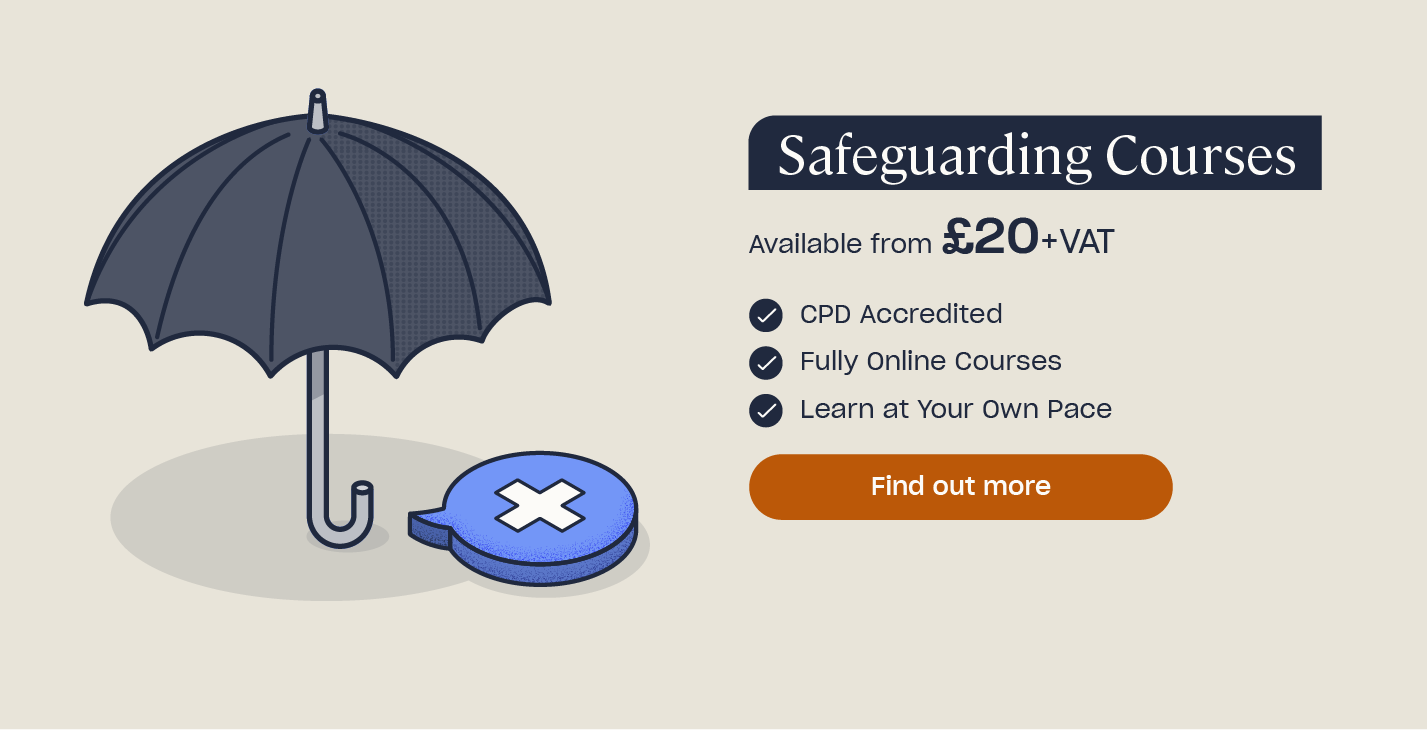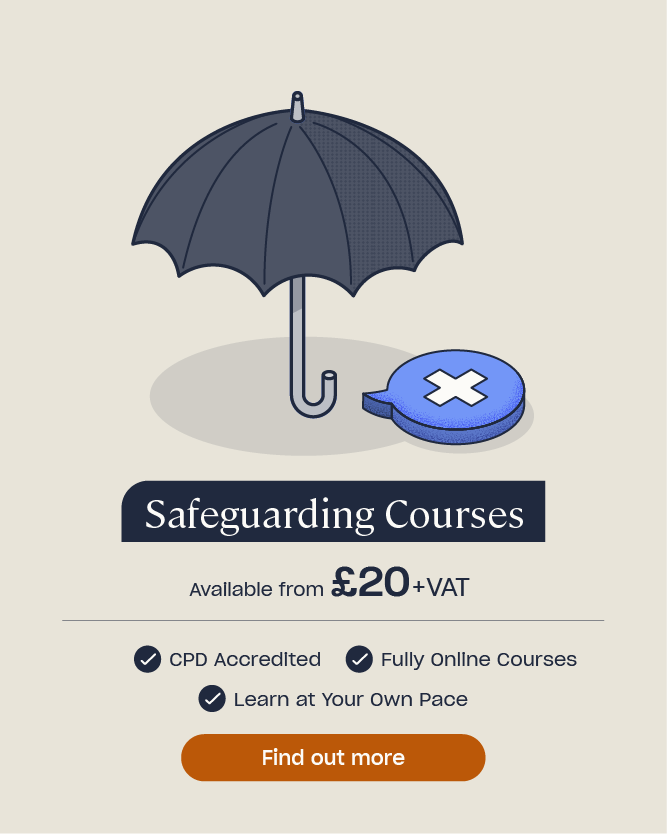Safeguarding Training Levels Explained: What’s the Difference?
Whether you work with adults or children, safeguarding training is crucial to ensure you are providing high-quality care and support. There are many different safeguarding training courses available and different levels to choose from, so it can be confusing trying to select the most suitable course for your role.
In this article, we will outline the different levels of safeguarding training and provide guidance on the information that they cover, helping you to choose the most appropriate course. Safeguarding is everyone’s responsibility, so ensuring you are completing the correct training for your role is vital.
If you wish to find further information about any of the courses outlined below, you can find all of our Safeguarding training, here.
Who Needs Safeguarding Training?
The term safeguarding is used to define actions taken to protect at risk groups from harm. As someone working closely with groups who have care and support needs, it’s important you understand what safeguarding is and why it’s important. Anybody who works with children and/or adults at risk, no matter how frequently, is required to have knowledge of safeguarding to ensure they are supporting and protecting those in their care. You can learn more about safeguarding in our article: What is Safeguarding?
Schools, charities, hospitals and care homes, along with other organisations, must all be invested in safeguarding and they have a legal responsibility to provide safeguarding training for all staff.
In the rest of this article, we will take you through the three different levels of safeguarding training and provide guidance on each, to help you decide which is required for your role.
What is Level 1 Safeguarding Training?
Level one safeguarding training is the most basic level and is an introduction to safeguarding, so no prior knowledge is needed to complete this level.
Level one safeguarding training will teach you what safeguarding is and why it is so important, as well as the different types of abuse and neglect, and how to identify that they are occurring. It will also cover how to respond to a disclosure, report your concerns and record information.
Jobs that Require Level 1 Safeguarding Training
Level one training is suitable for workers of all levels, including managers, supervisors, full-time staff, part-time staff and volunteers.
Examples of people who may take this training include:
- Teachers, nursery workers, teaching assistants, carers and childminders.
- Doctors, nurses, paramedics and health workers.
- Social workers, council staff and immigration workers.
- Youth workers, activity leaders and volunteers.
- Sports coaches and teachers.
- Church leaders, religious leaders and volunteers.
- NHS staff, such as GPs, nurses and healthcare assistants.
- Carers, both in a residential home or domestic setting.
- Private healthcare workers.
- Taxi drivers and bus drivers.
- Workers who enter people’s homes, such as gas engineers, maintenance workers and cleaners.
- Health and social care professionals, such as paramedics and health visitors.
- Council staff and immigration workers.
This list is not exhaustive and, depending on your duties, you may need a higher level of safeguarding training. If you are unsure, ask your employer.
Take a look at our range of level one courses including Introduction to Safeguarding Children, Introduction to Safeguarding Adults and Safeguarding Essentials.

What is Level 2 Safeguarding Training?
Level two safeguarding training is often referred to as ‘advanced’. This level of training develops and maintains your safeguarding knowledge, so you should already have some prior knowledge of safeguarding.
Level two training covers everything in level one but goes into further detail about safeguarding procedures, scenarios and what happens after a referral. It provides you with a thorough understanding of how to protect the children or adults you work with.
Jobs that Require Level 2 Safeguarding Training
The jobs mentioned as requiring level one safeguarding training may also require a level two qualification. This is likely to be dependent on the job and can vary between employers.
For example, teachers are expected to have an advanced level of safeguarding training. School staff have a duty of care to children and, being the ones who are likely to spend the most time with them, are likely to encounter the warning signs presented by abused children.
Anyone who engages in regulated activity will likely need level two safeguarding training.
Example job roles include:
- People that work in hospitals and GP surgeries.
- Workers in nursing homes, care homes and domiciliary care.
- Workers in religious organisations and community groups.
Take a look at our range of level two courses including Advanced Safeguarding Children and Advanced Safeguarding Adults.

What is Level 3 Safeguarding Training?
Level three safeguarding training refers to the training of a Designated Safeguarding Lead (DSL). This is someone who is the first point of contact for staff or those with access to the organisation you work for, and is a requirement in schools. DSLs are also responsible for ensuring that everyone in their organisation is following best safeguarding practices.
Level three courses offer information on the Designated Safeguarding Lead’s specific responsibilities. This may include content, such as working with other organisations and sensitively sharing the information in accordance with data protection laws.
The course is suitable for anyone wishing to understand the responsibilities of the Designated Safeguarding Lead, including those already in this position seeking further training and support, deputies and those assisting whoever holds the position, as well as those taking on a safeguarding lead for their organisation.
This level of training will include when and how to make safeguarding referrals, and how to work with other agencies to ensure all adults and children in your care receive the correct safeguarding support.
Jobs that Require Level 3 Safeguarding Training
Level three safeguarding training is designed for anyone who is in a position of responsibility in an organisation where adults at risk and/or children are present.
This includes, but is not limited to, managers, supervisors, and Designated Safeguarding Leads in:
- Care homes and residential settings.
- Social housing settings.
- Charities.
- Social and religious group setting.
- Adult education establishments.
- Sports clubs and leisure centres.
- Health and social care environments.
Take a look at our range of Level 3 courses including Designated Safeguarding Lead and Level 3 Safeguarding Adults Training.

If you are still uncertain as to what level of training you require, you should ask your employer for clarification. You must have an up to date knowledge of child and vulnerable adult safeguarding practices. As a result, it is recommended that you recomplete training every three years. Some training suppliers will offer refresher courses that are specifically tailored for this requirement.
If you work with children or adults in need, it is essential that you receive the correct level of training required for your role. Safeguarding is everyone’s responsibility and crucial to keep people safe. If you have any further questions or wish to find out more information on the topics covered in this article, please don’t hesitate to get in touch with us at High Speed Training!
Further Resources:
- Safeguarding Training Courses
- What is Safeguarding Training & Why is it so Important?
- Safeguarding Children Legislation: Guidance for School
- Safeguarding Adults Quiz
- Safeguarding Scenarios and Answers for Education
- Safeguarding Flowchart: Procedure for Reporting Concerns











